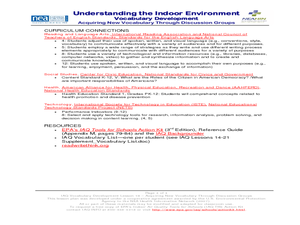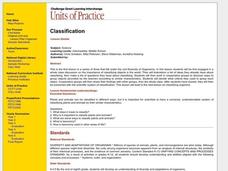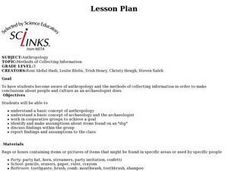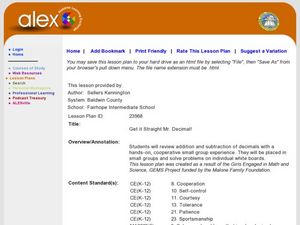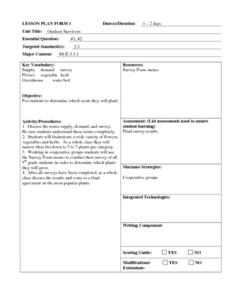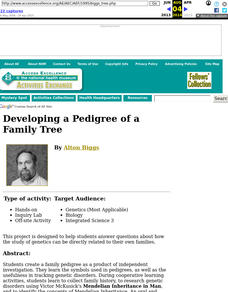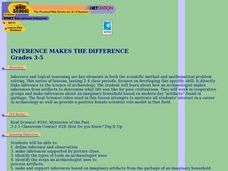Curated OER
Understanding the Indoor Environment: Vocabulary Development
Pupils acquire new vocabulary by reading an assigned text and determining the meanings of unfamiliar words. In this vocabulary development lesson, students acquire strategies to use in a small group as they decode meanings of...
Curated OER
Classification
Students investigate how to classify items based on similar characteristics. They study the scientific system of classification.
Curated OER
Building Trust
Students complete activities about trust. In this trust lesson, students discuss trust and working together. Students work in groups to build a LEGO creation using trust and cooperation. Students discuss the overall process and the role...
Curated OER
Applying Scientific Method to Analyzing
Young scholars review the scientific method and basic lab skills, and practice how chemical employees work in teams to follow the scientific method. Students learn about various job requirements and responsibilities in the chemical...
Curated OER
Methods of Collecting Information
Third graders examine a bag or box of soil containing items that they dig for. Their task is to become detectives to make conclusions about the area from which the items came as real archaeologists do.
Alabama Learning Exchange
Using an Almanac
Young scholars work cooperatively in order to identify specific situations in which an almanac is the best choice for locating information. They answer specific questions, record the page on which the answer was found, and the key words...
Curated OER
Solar Oven
Students construct a solar oven using cardboard, duct tape, aluminum foil and other materials. They use the solar oven to cook something and keep a journal of their project.
Curated OER
Get it Straight Mr. Decimal!
Students work with decimals. In this decimal instructional activity, students participate in a hands-on group activity that enable them to review to how to appropriately add and subtract decimals.
Curated OER
Introduction to Seeds
Students investigate how to plant a seed. In this gardening lesson, students listen to the book I'm a Seed and research the materials needed to plant a seed. Students present the information they found.
Curated OER
Fascinating Creatures
Sixth graders explore the characteristics of mythological creatures. In this mythology lesson plan, 6th graders use print and Internet sources to define and classify mythological creatures, such as Centaur, Cerberus, Chimera, Cyclops,...
Curated OER
Stitching Our Way Through Time to Learn About Nebraska Animals
Students study about animals that have lived in Nebraska in the past, and animals that currently live in Nebraska. They examine how animal life changed since the early beginnings and what has caused these changes?
Curated OER
Outdoor Survivors
Fifth graders complete a survey to decide what are most popular plants among the class. They test the water quality in a nearby pond. Studnts test the quality of soil samples taken from their homes. Different plants are moistened with...
Alabama Learning Exchange
Waste Not, Want Not
Pupils determine what materials are able to be recycled. In this environment protection lesson, students read The Three R's: Reuse, Reduce, Recycle and discuss landfills. They are given an item to decide if it can be recycled. They play...
Curated OER
Designing More Effective Packages
Young scholars make an environmentally sound package. In this packaging lesson students examine various types of modern packaging. The problem of waste is discussed leading into a discussion of waste reduction. The young scholars choose...
Curated OER
Load! Ready! Fire!
Pupils will identify the parts of a cannon and practice demonstrating a mock firing. In this math and science lesson, students read background information on the cannon and its firing. Pupils read about and role play positions near the...
Curated OER
Developing a Pedigree of a Family Tree
Students create a family pedigree as a product of independent investigation. They learn the symbols used in pedigrees, as well as the usefulness in tracking genetic disorders. During cooperative learning activities, students learn to...
Curated OER
Can You Control Floods
Students assume the role of an engineer or planner. As an engineer or planner they must come up with ideas that can be put into place to control floods. They produce a working model of flood control.
Curated OER
Static Electricity Experiments
Pupils investigate static electricity. They conduct two experiments, make observations and predictions, collect and record data, and write a report describing the findings of their investigations.
Curated OER
The Human Body: Focusing on Respiratory and Circulatory Systems
Students study the components and functions of the respiratory and circulatory systems. They take blood pressure using a stethoscope and investigate ways to maintain a healthy respiratory system.
Curated OER
Inference Makes the Difference
Students explore how archaeologists make inferences from artifacts to explore what life was like in the past. In this archaeology lesson, students work in groups and make inferences about an imaginary household based on modern day...
Curated OER
From Future Flight to Past Flight
Students complete a set of CD-ROM's to introduce them to the flight program at NASA. In groups, they research a topic related to flight and put their information on a CD-ROM. To end the instructional activity, they share their material...
Curated OER
Metric Conversion
Seventh graders convert within the metric system of measurement. In this seventh grade math/science instructional activity, 7th graders view a PowerPoint presentation that introduces metric conversion. Students use the Stair-step...
Curated OER
There's Gotta Be An Angle
Students examine the external variables that affect a downhill skier in the quest for speed. They access websites imbedded in this plan to become ski teams competing against one another. Each team presents results of all experiments.
Curated OER
CAN'T TOUCH THIS!
Young scholars discover the best practical shielding material when dealing with radioactive substances. They draw conclusions based on availability of materials, price, and best shielding properties.


